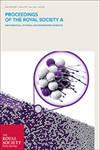通过单面六边形网格的无限小折纸映射编程四元元曲面:第一部分
IF 2.9
3区 综合性期刊
Q1 MULTIDISCIPLINARY SCIENCES
Proceedings of the Royal Society A: Mathematical, Physical and Engineering Sciences
Pub Date : 2024-02-01
DOI:10.1098/rspa.2023.0430
引用次数: 0
摘要
控制复杂元表面的形状是文献中经常提到的一项具有挑战性的任务。这项研究提出了一类棋盘格板,在任何挠曲载荷的作用下,它们都能变形为预设形状的表面,并且可以由单个致动器控制。四元元曲面是从平面的单面六边形棋盘格的无穷小折纸映射中获得的,即所有棋盘格相互全等的铺面。单面棋盘格部分可以连接在一起,以获得更复杂的形状,这些形状可以是局部同向或反向的,也可以具有一定的粗糙度。我们拓宽了之前的工作范围,提供了由不规则六边形组成的所有三种已知单面体细分结构的完整特征。所提出的二维结构可应用于假肢、组织工程、可穿戴设备、能量收集设备、可调聚焦镜和自适应外墙。本研究分为两个部分。在第一部分中,在介绍了网格板的离散运动学之后,分析证明了每种单面六边形网格板基本上只具有一种变形模式。随后,我们提供了几个数值示例,展示了各种可实现的表面形状。在第二部分中,首先对与指定瓷砖几何形状相对应的元曲面进行连续描述,从而确定连续插值总是一个四边形。然后,报告了有关制造、装配和表面精度的实验结果。本文章由计算机程序翻译,如有差异,请以英文原文为准。
Programming quadric metasurfaces via infinitesimal origami maps of monohedral hexagonal tessellations: Part I
The control of the shape of complex metasurfaces is a challenging task often addressed in the literature. This work presents a class of tessellated plates able to deform into surfaces of preprogrammed shape upon activation by any flexural load and that can be controlled by a single actuator. Quadric metasurfaces are obtained from infinitesimal origami maps of monohedral hexagonal tessellations of the plane, that is pavings in which all tiles are congruent to each other. Monohedral tessellated portions can be joined together to obtain more complex shapes, which can be locally synclastic or anticlastic and can have a certain roughness. We broaden previous work by providing a complete characterization of all the three known types of monohedral tessellations composed by irregular hexagons. The proposed two-dimensional structures may have applications in prosthetics, tissue engineering, wearable devices, energy harvesting devices, tunable focus mirrors and adaptive facades. The study is divided in two parts. In Part I, after introducing the discrete kinematics of tessellated plates, it is proved analytically that essentially each type of monohedral hexagonal tessellation possesses only one deformation mode. Afterwards, several numerical examples are provided to demonstrate the variety of achievable surface shapes. In Part II, first the metasurfaces corresponding to assigned tile geometries are given a continuum description, which establishes that the continuous interpolant is always a quadric. Then, experimental results on fabrication, assembly and surface accuracy are reported.
求助全文
通过发布文献求助,成功后即可免费获取论文全文。
去求助
来源期刊
CiteScore
6.40
自引率
5.70%
发文量
227
审稿时长
3.0 months
期刊介绍:
Proceedings A has an illustrious history of publishing pioneering and influential research articles across the entire range of the physical and mathematical sciences. These have included Maxwell"s electromagnetic theory, the Braggs" first account of X-ray crystallography, Dirac"s relativistic theory of the electron, and Watson and Crick"s detailed description of the structure of DNA.

 求助内容:
求助内容: 应助结果提醒方式:
应助结果提醒方式:


